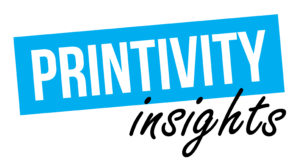Last updated on November 7th, 2022 at 05:13 pm
Knowing the difference between conversion rate vs click through rates can help a small business owner improve their web design and their online marketing.
Today I want to share two really important metrics that I think you should use to analyze your website. I use them all the time to analyze various parts of Printivity.com’s web pages, and it’s empowering to have a solid grasp of what they mean to your website.

Click Through Rate (CTR): % People Clicking on your Google Listing
Let’s say that you have a website that’s listed on Google—it’s not a great ranking, but you get some hits from time to time. That’s where a lot of businesses are these days: they put up a website, but they don’t know how to boost their rankings.
Your website’s Click-Through Rate is the % of people that click on your website, when Google shows them your website. Let’s say that your website is shown to 100 people (aka 100 impressions). If 5 people click on your webpage on Google, your “click-through rate” is 5%.
The formula to calculate click-through rates is Clicks ÷ Impressions = Y x 100 (percentage) = % CTR.
In other words, click-through rate is “how likely someone is to click on your Google listing”. There are many factors that would impact your click through rate, such as:
- The higher you’re ranked, the more likely Google users are to click on you
- Better written listing titles
- Better written listing descriptions
Conversion Rates: % of Visitors who Buy Online
Next, let’s discuss what “Conversion Rates” means to your website.
Conversion rate refers to the % of your online visitors who end up buying something from you online. In other words, if 100 people land on your website, and 3 people buy from you, your conversion rate is 3%.
This means that conversion rate is how likely an online visitor to buy from you. You can influence the conversion rates online through better salesmanship (i.e. more enticing copywriting, product photos, coupons/deals). Or, you can influence the conversion rates through better web design (easier/better designs, clearer calls-to-action, online checkouts and instant quoters).
Again, my focus today is to summarize the difference and connections. If you’d like to read more about conversion rates, check out 13 Ways to increase Your Conversion Rate Right Now.
Conversion Rate vs Click Through Rate
Click-Through Rates target people before they land on your site. Conversion Rates target people that are already on your site. Both require different strategies.
If you notice how I described Click-Through Rates, you’re targeting people searching on Google. You’re trying to change up your listing to entice them to click-through on your website. Even though I mentioned Google as the example, you can actually take this same concept and apply it to all your other types of online marketing – social media, paid online ads, etc.
Fundamentally, you’re changing up your listing, ranking higher to be more visible, and enticing visitors on other websites to click-through to you.
On the other hand, improving conversion rates targets people that are already your website. You do so with through fairly traditional salesmanship/marketing concepts. Improve your website’s salesmanship, and you’ll improve your conversion rates.
Here’s How I Visualize the Relationship Between CTR and Conversion Rates
Here’s a visual of the online sales funnel to illustrate how CTR is related to Conversion Rates:
In this particular example, 600 users “clicked through”, out of the 10,000 “impressions” (times my website was shown). That means I have a 6% Click-Through Rate (600/10,000).
Next, I made 24 sales out of the 600 people that clicked through to my site. That means I have a 4% Conversion Rate (24 / 600).
Optimizing any part of the funnel translates pretty directly into improvements in sales.
1. If you’re able to double your impressions (i.e. by ranking higher on Google), it’s as good as doubling your Google SEO sales.
2. If you increase your CTR by 10% (i.e. by improving your search listings), you’ll increase your sales by 10%
3. If you increase your conversion rate by 50% (i.e. by redesigning your most trafficked product page), you’ll increase that product’s online sales from Google SEO traffic by 50%!
The tricky part is to experiment—bit by bit—with your web design to make all the small improvements to improve your online marketing performance!
Conversion rate and click-through-rates are only some of the analytics that your team should be keeping track of. Learn about the 12 Insights To Start Your Business Analytics!








